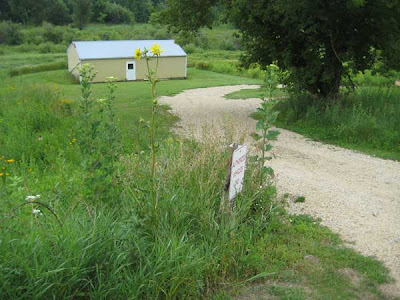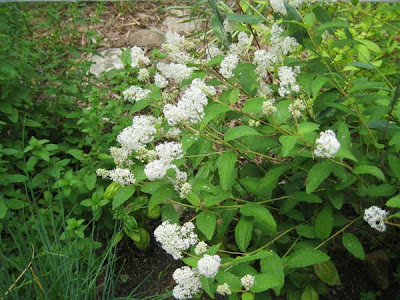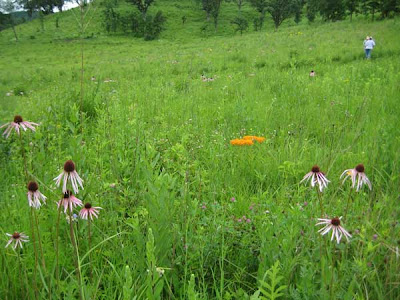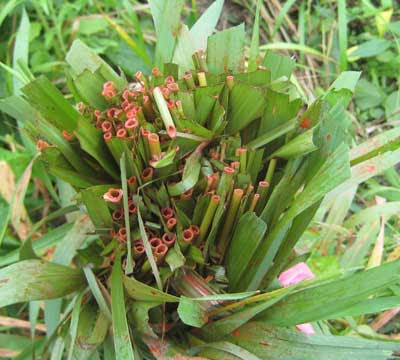Black Earth Rettenmund Prairie is well known as an outstanding prairie remnant. Many people may not know that it is also heavily infested with sweet clover (
Melilotus alba), one of the worst invaders of natural areas.
As part of our management activities at Rettenmund Prairie, Kathie and I organize (and pay for) sweet clover control. Because this plant is a biennial, there are generally "good" years and "bad" years. This year sweet clover is especially bad.

Right now, butterfly milkweed is in full bloom, providing a great color display. However, as the photo to the left shows, sweet clover pushes its way up, threatening to eventually dominate the prairie. The solution is to eliminate all flowering plants of sweet clover. If we keep them from making seed, we should eventually be able to exhaust the seed bank and eliminate this menace. We have been working on this problem for at least six years; who knows how much longer this will take? (See some thoughts at the end of this post.)

The principal control method is hand pulling. If you pull up the whole plant, root and all, you have eliminated it. The smaller plants can be easily dealt with this way, although it helps if the ground is moist. A strong person can also pull the larger plants, but weaker folks find it necessary to use a shovel. (The Parsnip Predator, a special shovel designed by the Prairie Smoke chapter of The Prairie Enthusiasts, works great.) The photo to the left shows Kathie pulling tiny sweet clover plants that are hiding among a nice patch of
Coreopsis palmata. There is a lot of "stoop" work with sweet clover control!
Unfortunately, Rettenmund Prairie also has large patches which are almost solid sweet clover. These could be pulled but the task would be really daunting. Mowing is the only solution. However, timing here is critical, since if a plant is mowed too early it will resprout, and if it is mowed too late, it will already have set seed. We have been monitoring the Prairie for the past several weeks and decided that now was the time to mow.
Our friendly neighbor Dean Lucey (retired dairy farmer) kindly mowed some really large patches with his tractor. Yesterday, Heisley and Marci mowed a number of smaller (but still large) patches with Stihl brush cutters.

As part of the mowing process, it is essential that the "good" plants be saved. Especially now, when the colorful butterfly milkweed is in full bloom, it would be a shame to destroy it. The procedure here is to hand pull all the sweet clover "outliers", leaving only the solid patches for the mowers. The photo below shows a mowed patch with butterfly milkweeds still intact.

Since we have been controlling sweet clover at Black Earth Rettenmund for six years, why does it continue to be so bad?
Several characteristics of sweet clover need to be mentioned. First, it produces seeds that are capable of remaining alive for many years in the soil. (Some sources say at least 30 years.) Second, seed germination is induced by fire.
Throughout the 20 years or so that the Nature Conservancy owned Rettenmund Prairie, parts of it were burned every year, which would have stimulated seed germination. Although sweet clover control was part of the TNC management program, the infestation never seemed to abate.
Since Kathie and I took over management of Rettenmund Prairie, sweet clover control has been one of our major activities. Obviously, we need to keep controlling sweet clover until we have exhausted the seed bank. Unfortunately, this may take a generation or two. A rather dismal prospect!















